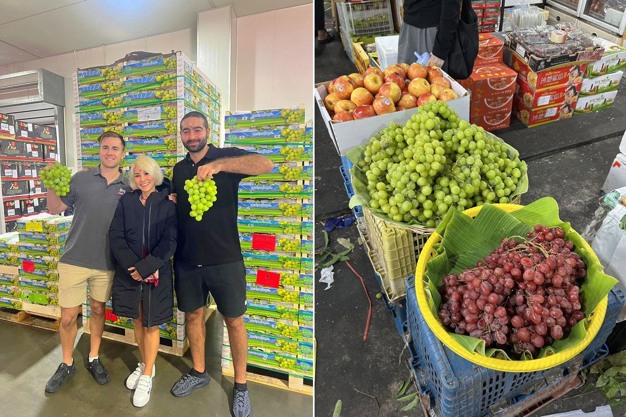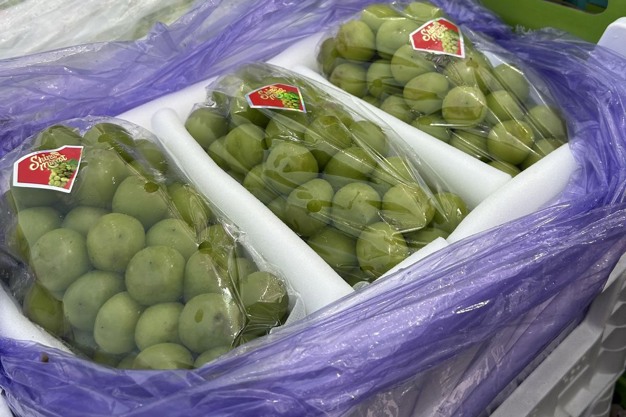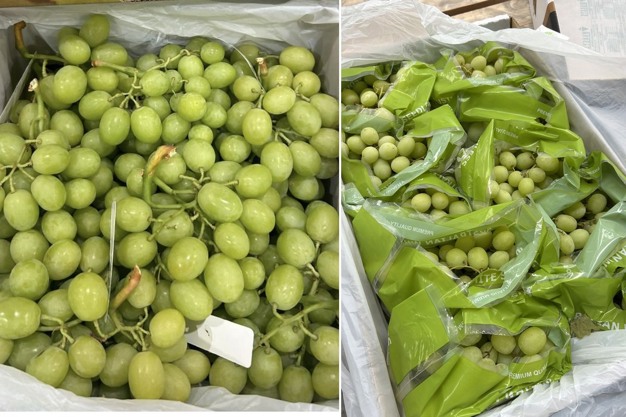The global grape market is undergoing a major transformation. In Asia, South America, and the United States, exporters, retailers, and growers are facing new realities shaped by shifting consumer trends, rising competition, and logistics bottlenecks. Where does the grape market in these regions stand today, and where is it headed?
Global competition intensifies
From a consumption perspective, demand in Asia is generally down as post-COVID economic softness continues. "Disposable income of consumers is down, but their expectations are higher than ever," says Dalton Dovolis with International Produce Group (IPG). "Shoppers now browse aisles filled with table grapes, cherries, apples, and more originating from four to six different countries simultaneously." Chile's record cherry crop flooded Asia at extremely low prices, significantly impacting grape demand. In key markets like Hong Kong, blueberries have surged in popularity, becoming a direct competitor to grapes due to perceptions of health benefits and convenience.
"During my recent trip to Asia, wholesale markets simultaneously featured grapes from Peru, Chile, South Africa, Australia, India, China, and even counterfeit Australian grapes from China," shared Dovolis. With so many options available, competition and consumer standards have elevated sharply. Unlike previous seasons, Asian markets now prioritize taste and stem freshness over size and general appearance. "Our Peruvian grapes, despite impressive sizing, struggled due to dehydrated stems, while Australian grapes, slightly smaller but fresher, captured market preference."
Interestingly, despite these challenges, grape consumption and purchasing volumes in certain Asian countries continue to increase annually, particularly during the November–April period coinciding with the Peruvian and Chilean grape season. However, returns to growers from these countries have simultaneously decreased year-over-year. This paradox results primarily from global oversupply during this window. Too many grapes from multiple origins flood markets faster than demand can absorb, creating significant downward pressure on prices. Growers must carefully manage planting decisions and strategically allocate markets to maintain profitability.
 © IPGLeft photo: Dalton Dovolis (left) of International Produce Group (IPG), alongside a Thailand receiver and a Peruvian grape grower, proudly showcasing a fresh arrival of premium Autumn Crisp grapes in Bangkok. Right photo: Chinese grapes in the wholesale market of Cambodia.
© IPGLeft photo: Dalton Dovolis (left) of International Produce Group (IPG), alongside a Thailand receiver and a Peruvian grape grower, proudly showcasing a fresh arrival of premium Autumn Crisp grapes in Bangkok. Right photo: Chinese grapes in the wholesale market of Cambodia.
Asia's new reality: price, taste, and freshness
At retail levels across Asia, grapes are frequently sold loose without branded packaging or country-of-origin labeling. This means grapes compete primarily based on freshness, taste, size, and price. Asian consumers overwhelmingly prefer premium green seedless varieties, particularly Autumncrisp® and Sweet Globe™. Demand for premium red and black seedless varieties continues declining annually, although niche markets remain for high-quality specialty grapes such as Sweet Celebration, Ruby Rush, and various candy and muscat varieties.
Even popular candy varieties from the U.S. face downward pressure due to severe oversupply. "While traveling in Asia, approximately 90 percent of grapes sold were green seedless, and out of that share, 85 percent were Sweet Globe and Autumncrisp," Dovolis noted. "Quality, however, varies significantly among growers and regions."
Moving forward, Dovolis firmly believes that only grapes of the highest quality will survive and thrive in Asia. "There is simply no room for mediocre or average fruit." Asian markets are now selecting and buying exclusively top-tier premium quality, and this trend is already clearly visible in grapes from the U.S., Peru, and Chile. The price differences in the market are staggering—for a premium-quality green grape versus a mediocre or below-average offering, the difference can easily reach $20 per box. Only the best quality fruit will secure growth opportunities, as Asia now has the luxury to be extremely selective.
 © IPGChinese Muscat grapes in Vietnam
© IPGChinese Muscat grapes in Vietnam
Peru faces heavy competition from Australia
Peru remains a major grape exporter to Asia, but faces increasingly stiff competition from Australia, especially post-Chinese New Year (CNY). Australian grapes benefit greatly from shorter transit times, arriving fresher and in superior condition. "In Southeast Asia, I saw Peruvian grapes with December and January pack dates next to Australian grapes packed in March," said Dovolis.
While consumers don't eat the stems, their freshness has become a crucial indicator of marketability. Previously, Peruvian grapes could enter markets with slightly dry stems without major problems, but today they're heavily penalized due to competition from Australia and South Africa, who leverage faster transit times and airfreight capabilities. Improving logistics and securing airfreight access to key Asian markets—currently restricted by phytosanitary protocols—is critical for Peru to maintain market share.
 © IPGLeft: fresh arrival of Australian Autumncrisp grapes in Vietnam. Right: fresh air arrival of Australian Sweet Globes in Bangkok.
© IPGLeft: fresh arrival of Australian Autumncrisp grapes in Vietnam. Right: fresh air arrival of Australian Sweet Globes in Bangkok.
U.S. grapes face rising competition from China
China has rapidly emerged as the largest competitor, transforming into a global powerhouse in grape production, quality, logistics, and market control. "China's grape quality has surged dramatically, with varieties like Crimson, Long Crimson, Red Globe, Melody™, Sweet Sapphire™, and Adora® consistently arriving with strong stems, vibrant color, and exceptional freshness," explained Dovolis. Chinese grapes are 30-40 percent cheaper than American grapes, further intensifying competition. Additionally, China now produces two Red Globe crops per year, making them a consistent year-round grape supplier without an offseason.
China used to be a major customer for American and South American grapes, but today they're becoming the toughest competitor. "During the California grape season, China primarily challenges us in red seedless grapes but is increasingly planting premium green and proprietary varieties."
Long and unreliable transit times
Far East markets such as the Philippines, Indonesia, Malaysia, and Vietnam are particularly stringent regarding grape quality, requiring extremely fresh stems and perfect appearance. Meanwhile, U.S. grape prices continue rising due to increasing labor costs and ironically, ocean shipping transit times from the U.S. have dramatically worsened. Asian retailers hesitate to purchase U.S. grapes shipped by ocean due to quality deterioration upon arrival.
"At IPG, logistical challenges have dramatically reshaped our export strategy. Previously, nearly 90 percent of our grapes shipped via ocean freight, but due to increasingly unreliable and slow ocean transit times, over half now move by air. While airfreight limits overall volume and adds costs, it ensures grapes arrive fresh enough to justify premium pricing in Asia's increasingly selective markets. Unfortunately, high airfreight costs restrict the total volume we can move; however, this approach is essential for protecting the premium quality and reputation of American grapes. 'We're committed to preserving our growers' reputations and market relevance by consistently delivering fruit in optimal condition,' explained Dovolis. 'Until ocean logistics from the U.S. significantly improve, strategically utilizing airfreight allows us to protect grower returns and maintain competitiveness against China's faster and more cost-effective supply.'"
Diversifying markets for future growth
From Asia to South America and North America, the grape industry stands at a crucial turning point. "The future of grapes depends on speed, condition, and adaptability," emphasized Dovolis. "Growers from Peru, Chile, and the U.S. must diversify their markets. At IPG, we remain committed to expanding market opportunities and helping growers navigate this complex landscape. We continue to actively seek every available market opportunity, providing growers maximum diversity for their fruit and returns. We remain dedicated to ensuring the highest possible success for all growers, aiming to support the prosperity and sustainability of the grape industry for generations to come."
Optimistic outlook for U.S. growers
"After speaking with customers across Asia, there's strong optimism for the upcoming U.S. grape season—provided potential tariff and trade war challenges can be navigated successfully. I strongly encourage growers to maintain their commitment to premium green seedless varieties, continue investing in differentiated branding and innovative packaging, and adopt post-harvest technologies that enhance grape durability. Even if logistics remain difficult, exceptional-quality grapes, presented thoughtfully, will consistently find eager markets. Let's continue adapting proactively, confidently protecting, and expanding our presence in these vital global markets."
 For more information:
For more information:
Dalton Dovolis
International Produce Group (IPG)
Tel: (+1) 831-754-9740
ddovolis@producegroup.net
www.internationalproducegroup.com
